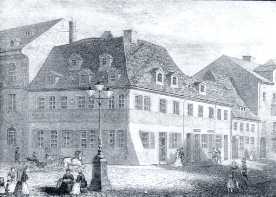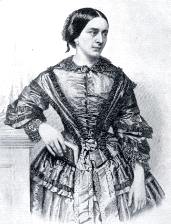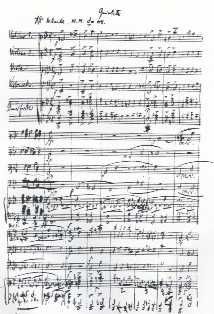Composer (MIDI)
Robert Alexander Schumann (1810-1856); DEU
 Loading, please wait...
Loading, please wait...
There is a good case to be made that Robert Schumann is the purest embodiment of early romanticism in music. Born in 1810, the son of a bookseller, Schumann found his earliest musical inspirations in the German Romantic literature of Jean Paul and E.T.A. Hoffman. And in love. The first ten years of his compositions are a veritable diary of his courtship of Clara Wieck, the daughter of his piano teacher, who was nine years his junior.

Robert dutifully tried law school per his mother's wishes, but could not resist hours of improvising at the piano. He was really somewhat of a late bloomer to be a serious musician but was intent on becoming a piano virtuoso. In his desire to make up for lost time, he built a mechanical device to strengthen his 4th finger. The subsequent injury this caused changed his career path to composition.
One can sympathize a bit with Clara's strict and imperious father, who considered Robert both too impetuous and certainly too old for his daughter, who he was successfully grooming to be one of the century's great pianists. Hers was a strict classical training, and in later years she convinced Schumann that if he aspired to the loftiest goals, he must compose grand sonatas and symphonies in addition to the suites of fantastic dances, miniatures and poetic rhapsodies that were his natural metier.
Schumann's early piano music is profoundly original. The Papillons, Opus 2, takes a Schubertian cycle of dances as its point of departure, but with Schumann these suites of character pieces become embodiments of his own dual nature, represented by the outgoing Florestan and the dreamy Eusebius.
Schumann was an idealistic champion for the purity and poetry of the new romantic spirit, and an enemy of the idle virtuousity and note spinning that were competing for the attention of the rising middle class audience. All this is evident in pieces such as the Davisbundlertanze, 0pus 6, and the Carnival, Opus 9, where the movements depict Schumann's imaginary band of David against the philistines. Here we have Florestan's energetic dotted rhythms contrasting with the introspective musings of Eusebius, and movements entitled Chopin and Paganini.

In addition to composing, Schumann became the editor for the Neue Zeitschrift fur Musik for ten years, during which time he was one of the most generous and perspicacious of critics. His first review introduced Chopin to the world and his last, Brahms.
Meanwhile, there was not a sonata to be seen at this point. Yet for all Schumann's caprice and fantasy, he was one of the purist musicians with innate sense of classical balance and proportion. His strength was in the juxtaposition of exquisite miniatures to form a convincing and cumulative mosaic, rather than the kind of ongoing developmental musical argument needed for sonata writing.
The travails of the romance between Robert and Clara is one of the great love stories (with soundtrack) of the century. Much of time they were forbidden to see one another and Schumann communicated in one piano masterpiece after another. Opuses 1 through 28 are all for piano, and in addition to the pieces already named, include Kreisleriana, Fantasiestucke, the glorious C major Fantasy and the often overlooked Humoreske.
If Brahms had the autumnal character of an old man even in his youth, Schumann was in many way always the ardent boy. His sympathy with the world of children produced the adult reminiscences of childhood in the Kinderszenen, Opus 15. The beauty of the music almost keeps us from realizing how much organically grows out of a single turn of phrase that appears in piece after piece, and that Schumann was also one of the great musical theorists. Later in his life, he wrote directly for his own children in the Album for the Young that has nurtured countless young pianists since.

In 1840, Robert and Clara finally married. This became the year of the song. Schumann tended to obsessively concentrate on one genre at a time before exhausting himself and moving on to the next. Thus this year produced his great song cycles including the Dichterliebe, Opus 48. In this setting of Heine poetry, Schumann again takes his point of departure from Schubert, with piano preludes and postludes that offer deep insights and comments on the poetry. The Beautiful Month of May that begins the cycle starts with an ambiguity of key and emotion that immediately immerses us in the wistful and ironic world of the poetry.
In 1841, Schumann began his concentration on the Symphony, of which he went on to write four. All four are inspired and the old criticisms about the thickness of the orchestration has been challenged by recent recordings including some on original intruments. 1842 was the year of chamber music including the A major Piano Quintet-the first of its type, and 1843 was the year of choral music
After going on a Russian tour with Clara in 1844, Schumann had a severe attack of depression. The polarities of his inner world eventually would lead to Schumann's increasing emotional instability. A growing family brought its own pressures along with the difficulty of balancing two careers. The Schumanns moved a number of times unsuccessfully searching for a calming environment. After throwing himself into the Rhine in 1854, Robert's condition necessitated his being institutionalized. His alternating periods of intense creativity (the Spring Symphony was sketched inside a week) with depression have certainly led to speculations of bi-polar disorder. In any event Robert's slide into some sort of madness in his last two years until his death in 1856 is heartbreaking. Schumann composed almost until the end and there are important works throughout his life that are still performed surprisingly infrequently.
Biography by Allen Krantz. Copyright © Classical Archives, LLC. All rights reserved.
###
Schumann, Robert (Alexander) (b Zwickau, 1810; d Endenich, 1856). Ger. composer, pianist, cond., and critic. Studied law at Leipzig and Heidelberg Univs., but main interests were mus. and Romantic literature, e.g. Jean-Paul Richter. In 1828 met Clara Wieck, to whose father Friedrich he went for pf. lessons in 1829, lodging with him and beginning to compose. In 1832 permanently injured hand by device he had invented to keep 4th finger immobile while practising. Was already contributing mus. criticism to Ger. papers and in 1831 called attention to Chopin's genius. Depressed by mus. situation in Ger., founded ‘David Club’ in 1834 to fight artistic philistines, and periodical Neue Zeitschrift für Musik, which he ed. for 10 years. In writings and comps., gave himself dual personality: Florestan for his impetuous self and Eusebius for his contemplative side. In 1838 visited Vienna and discovered MS of Schubert's ‘Great’ C major sym., which he sent to Mendelssohn. Married Clara Wieck 1840 after long opposition from her father, this being followed by outpouring of songs and song-cycles. In 1841 concentrated on syms., in 1842 on chamber mus., and in 1843 choral works. Taught comp. at Leipzig Cons. Toured Russia with Clara, 1844. On return had severe attack of depression. Moved to Dresden in search of quiet, living there until 1850. In 1846 Clara gave f.p. of his pf. conc. and Mendelssohn cond. f.p. of 2nd Sym. In 1850 moved to Düsseldorf in hope of earning more by conducting, but was not a success. Met 20-year-old Brahms in 1853, acclaiming him in article ‘New Paths’. The next year his mental health failed and he threw himself into Rhine, but was saved and taken to private asylum where he lived another 2 years.
Schumann was one of the greatest composers for pf., enriching its literature with a series of poetic works in which classical structure and Romantic expression are combined. His vocal and chamber mus. is of comparable quality, with the freshness, vitality, and lyricism which also characterize the orch. works. His orchestration is sometimes criticized for its thickness and lack of fluency, and various attempts have been made to ‘improve’ the scoring, e.g. by Mahler, but the present-day tendency is to prefer the spontaneity of Schumann's own. His songs, particularly his song-cycles, are among the glories of Lieder. His works contain many musical quotations and allusions and a number of his themes have been shown to be musical cryptograms. Prin. comps.:
OPERA: Genoveva, Op.81 (1847-9).
INCIDENTAL MUSIC: Manfred, Op.115 (Byron) (1848-9).
ORCH.: syms.: No.1 in Bb (Frühling, Spring), Op.38 (1841), No.2 in C, Op.61 (1845-6), No.3 in Eb (Rhenish), Op.97 (1850), No.4 in D minor (begun 1841, 2nd in order of comp., rev. 1851), Op.120; Overture, Scherzo, and Finale, Op.52 (1841, rev. 1845); Overture to Shakespeare's Julius Caesar, Op.128 (1851); Overture on Goethe's Hermann and Dorothea, Op.136 (1851).
CONCERTOS, etc.: pf. conc. in A minor, Op.54 (1st movt. written as Fantasie 1841, rest added 1845); Konzertstück, 4 hn., in F, Op.86 (1849); Introduction and Allegro appassionato, pf., Op.92 (1849); vc. conc. in A minor, Op.129 (1850); Fantasy in C, vn., Op.131 (1853); Concert-Allegro and Introduction in D minor, pf., Op.134 (1853); vn. conc. in D minor, Op.2 posth. (1853).
CHORUS AND ORCH.: Das Paradies und die Peri (Paradise and the Peri), Op.50 (1843); Requiem für Mignon, Op.98b (1849); Nachtlied, Op.108 (1849); Der Rose Pilgerfahrt, Op.112 (1851); Der Königssohn, Op.116 (1851): Des Sängers Fluch, Op.139 (1852); Mass, Op.147 (1852); Requiem, Op.148 (1852); Scenes from Goethe's Faust (1844-53).
CHAMBER MUSIC: str. qts.: Op.41, No.1 in A minor, No.2 in F, No.3 in A (1842); pf. qts.: in C minor (1829), in Eb, Op.47 (1842); pf. quintet in Eb, Op.44 (1842); pf. trios: No.1 in D minor, Op.63 (1847), No.2 in F, Op.80 (1847), No.3 in G minor, Op.110 (1851); vn. sonata No.1 in A minor, Op.105 (1851), No.2 in D minor, Op. 121 (1851); Adagio and Allegro in Ab, hn. (or vn. or vc.), pf., Op.70 (1849); Fantasiestücke, cl. (or vn. or vc.), pf., Op.73 (1849); Fantasiestücke, pf., vn., vc., Op.88 (1842); 3 Romanzen, ob. (or vn. or cl.), pf., Op.94 (1849); Märchenbilder, va. (or vn.), pf., Op.113 (1851); 5 Pieces in Folk Style, vc. (or vn.), pf., Op.102 (1849); Märchenerzählungen, pf., cl. (or vn.), va., Op.132 (1853); pf. accs. to 6 vn. sonatas and partitas by J. S. Bach (1854).
PIANO: Abegg Theme with Variations, Op.1 (1830); Papillons, Op.2 (1829-31); 12 Concert Studies on Paganini Caprices, Set I, Op.3 (1832), Set II, Op.10 (1833); 6 Intermezzi, Op.4 (1832); Impromptus on a Theme by Clara Wieck, Op.5 (1833, rev. 1850); 18 Davidsbündlertänze, Op.6 (1837, rev. 1850); Toccata in C, Op.7 (1830); Allegro in B minor, Op.8 (1831); Carnaval: Scènes mignonnes sur 4 notes, Op.9 (1834-5); sonatas: No.1 in F# minor, Op.11 (1833-5), No.2 in G minor, Op.22 (1833-8), No.3 in F minor, Op.14 (1835, rev. 1853); 8 Fantasiestücke, Op.12 (1837-8); Études symphoniques (Symphonic Studies), Op.13 (1834-7, rev. 1852); Kinderscenen, Op.15 (1838); Kreisleriana, Op.16 (1838, rev. 1850); Fantasy in C, Op.17 (1836); Arabeske in C, Op.18 (1839); Blumenstück in Db, Op.19 (1839); Humoreske in Bb, Op.20 (1839); 8 Novelletten, Op.21 (1838); 4 Nachtstücke, Op.23 (1839); Faschingsschwank aus Wien, Op.26 (1839); 3 Romanzen, Op.28 (1839); Album für die Jugend, Op.68, Book I containing 18 pieces, Book II, 25 (1848); Waldscenen, Op.82 (1848-9); Bunte Blätter, Op.99 (1852); 3 Fantasiestücke, Op.111 (1851); 3 pf. sonatas ‘fur die Jugend’, Op.118 (1853); Albumblätter, Op.124 (1832-45); 7 Piano Pieces in the form of fugues, Op.126 (1853); 5 Gesänge der Frühe, Op.133 (1853).
PIANO DUETS: 6 Impromptus, Op.66 (1848), Ball-Scenen, Op.109 (1851).
ORGAN: 6 Fugues on the Name of Bach, Op.60 (1845).
PART-SONGS: mixed: 5 Lieder, Op.55 (1846); Romanzen und Balladen, 4 vols., Opp. 67, 75, 145, 146 (1846-9); women's: Romanzen, 2 vols., Opp. 69, 91 (1849); men's: 6 Lieder, Op.33 (1840); 5 Hunting-Songs, with 4 optional hn., Op.137 (1849).
SONGS & SONG-CYCLES: Liederkreis (Heine), Op.24 (1840); Myrthen, cycle of 26 songs, Op.25 (1840); Lieder und Gesänge, I, Op.27 (1840), II, Op.51 (1842), III, Op.77 (1840 and 1850), IV, Op.96 (1850); 12 Gedichte, Op.35 (1840); 6 Gedichte, Op.36 (1840); 12 Gedichte aus Liebesfrühling, Op.37 (1840); Liederkreis (Eichendorff), Op.39 (1840); Frauenliebe und -Leben, song-cycle, Op.42 (1840); Romanzen und Balladen, I, Op.45 (1840), II, Op.49 (1840), III, Op.53 (1840), IV, Op.64 (1841 and 1847); Dichterliebe, song-cycle, Op.48 (1840); Liederalbum für die Jugend, Op.79 (1849); 3 Gesänge, Op.83 (1850); 6 Gesänge, Op.89 (1850); 6 Gedichte, Op.90 (1850); 3 Gesänge, Op.95 (1849); 9 Lieder und Gesänge aus Wilhelm Meister, Op.98a (1849); 7 Lieder, Op.104 (1851); 6 Gesänge, Op.107 (1851-2); 4 Husarenlieder, Op.117 (1851); 3 Gedichte, Op.119 (1851); 5 Heitere Gesänge, Op.125 (1851); 5 Lieder und Gesänge, Op.127 (1850-1); Gedichte der Königin Maria Stuart, Op.135, (1852); 4 Gesänge, Op.142 (1852).
Copyright © 1996 Oxford University Press - By permission of Oxford University Press
###
Read biography at allmusic.com.

|
There is a good case to be made that Robert Schumann is the purest embodiment of early romanticism in music.... More
|
-
Keyboard Works
135 midis
- Variations, Piano Sonatas and Fantasies
19 midis
-
Other Solo Piano Works
107 midis
- Album für die Jugend, Op.68
22 midis
- Arabesque in C, Op.18
2 midis
- Blumenstück in Db, Op.19
1 midi
- Carnaval: Scènes mignonnes sur quatre notes, Op.9
1 midi
- 18 Davidsbündlertänze, Op.6
1 midi
- Humoresque in Bb, Op.20
1 midi
- Kinderszenen, Op.15
47 midis
- Kreisleriana, Op.16
2 midis
- Nachtstück, Op.23
1 midi
- 8 Novelettes, Op.21
8 midis
- Papillons, Op.2
1 midi
- 3 Romanzen, Op.28
1 midi
- Symphonic Etudes, Op.13
7 midis
- Toccata in C, Op.7
2 midis
- Waldszenen, Op.82
10 midis
- Album für die Jugend, Op.68
-
Piano Duo, Piano 4-Hands and Pedal Piano
7 midis
-
Organ Works
2 midis
- 6 Fugues on B-A-C-H, Op.60
2 midis
- 6 Fugues on B-A-C-H, Op.60
- Variations, Piano Sonatas and Fantasies
-
Chamber Works
13 midis
-
Chamber Sonatas
1 midi
-
Piano Trios, Piano Quartets and Piano Quintets
7 midis
- Piano Quintet in Eb, Op.44
4 midis
- Piano Trio No.2 in F, Op.80
1 midi
- Piano Trio No.3 in G-, Op.110
2 midis
- Piano Quintet in Eb, Op.44
-
Other Chamber Works
5 midis
-
Chamber Sonatas
-
Orchestral Works
22 midis
- Symphonies
15 midis
- Symphony No.4 in D- 'Clara', Op.120
3 midis
- Symphony No.1 in Bb, Op.38 ('Spring')
4 midis
- Symphony No.2 in C, Op.61
3 midis
- Symphony No.3 in Eb, Op.97 ('Rhenish')
5 midis
- Symphony No.4 in D- 'Clara', Op.120
-
Concertos and Other Orchestral Works
7 midis
- Symphonies
-
Vocal Works
16 midis
- Lieder
5 midis
- 3 Gedichte, Op.29
1 midi
- 5 Lieder und Gesänge, Op.51
1 midi
- Lieder-Album für die Jugend, Op.79
2 midis
- 3 Romanzen und Balladen, Op.49
1 midi
- 3 Gedichte, Op.29
-
Song Cycles
10 midis
- Dichterliebe, Op.48 (text by H. Heine)
1 midi
- Frauenliebe und-leben, Op.42
6 midis
- Liederkreis, Op.39 (Eichendorff)
1 midi
- Myrthen, Op.25 (text by H. Heine)
2 midis
- Dichterliebe, Op.48 (text by H. Heine)
-
Works for Chorus and Orchestra
1 midi
- Mass, Op.147
1 midi
- Mass, Op.147
- Lieder
-
Keyboard Works
135 midis
- Variations, Piano Sonatas and Fantasies
19 midis
-
Other Solo Piano Works
107 midis
- Album für die Jugend, Op.68
22 midis
- Arabesque in C, Op.18
2 midis
- Blumenstück in Db, Op.19
1 midi
- Carnaval: Scènes mignonnes sur quatre notes, Op.9
1 midi
- 18 Davidsbündlertänze, Op.6
1 midi
- Humoresque in Bb, Op.20
1 midi
- Kinderszenen, Op.15
47 midis
- Kreisleriana, Op.16
2 midis
- Nachtstück, Op.23
1 midi
- 8 Novelettes, Op.21
8 midis
- Papillons, Op.2
1 midi
- 3 Romanzen, Op.28
1 midi
- Symphonic Etudes, Op.13
7 midis
- Toccata in C, Op.7
2 midis
- Waldszenen, Op.82
10 midis
- Album für die Jugend, Op.68
-
Piano Duo, Piano 4-Hands and Pedal Piano
7 midis
-
Organ Works
2 midis
- 6 Fugues on B-A-C-H, Op.60
2 midis
- 6 Fugues on B-A-C-H, Op.60
- Variations, Piano Sonatas and Fantasies
-
Chamber Works
13 midis
-
Chamber Sonatas
1 midi
-
Piano Trios, Piano Quartets and Piano Quintets
7 midis
- Piano Quintet in Eb, Op.44
4 midis
- Piano Trio No.2 in F, Op.80
1 midi
- Piano Trio No.3 in G-, Op.110
2 midis
- Piano Quintet in Eb, Op.44
-
Other Chamber Works
5 midis
-
Chamber Sonatas
-
Orchestral Works
22 midis
- Symphonies
15 midis
- Symphony No.4 in D- 'Clara', Op.120
3 midis
- Symphony No.1 in Bb, Op.38 ('Spring')
4 midis
- Symphony No.2 in C, Op.61
3 midis
- Symphony No.3 in Eb, Op.97 ('Rhenish')
5 midis
- Symphony No.4 in D- 'Clara', Op.120
-
Concertos and Other Orchestral Works
7 midis
- Symphonies
-
Vocal Works
16 midis
- Lieder
5 midis
- 3 Gedichte, Op.29
1 midi
- 5 Lieder und Gesänge, Op.51
1 midi
- Lieder-Album für die Jugend, Op.79
2 midis
- 3 Romanzen und Balladen, Op.49
1 midi
- 3 Gedichte, Op.29
-
Song Cycles
10 midis
- Dichterliebe, Op.48 (text by H. Heine)
1 midi
- Frauenliebe und-leben, Op.42
6 midis
- Liederkreis, Op.39 (Eichendorff)
1 midi
- Myrthen, Op.25 (text by H. Heine)
2 midis
- Dichterliebe, Op.48 (text by H. Heine)
-
Works for Chorus and Orchestra
1 midi
- Mass, Op.147
1 midi
- Mass, Op.147
- Lieder









 Files of this type are not available at this time. Please select ALL from above.
Files of this type are not available at this time. Please select ALL from above.
 Click on a category to view the list of works
Click on a category to view the list of works


